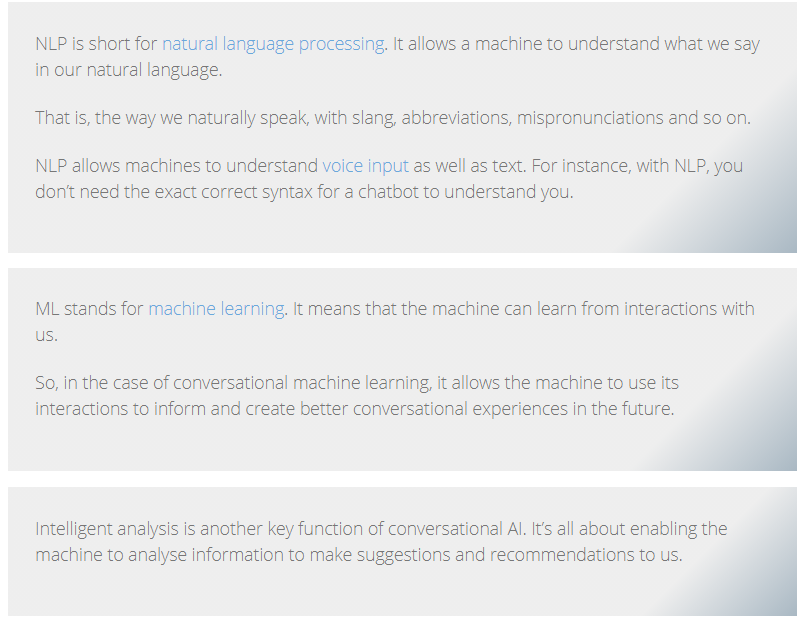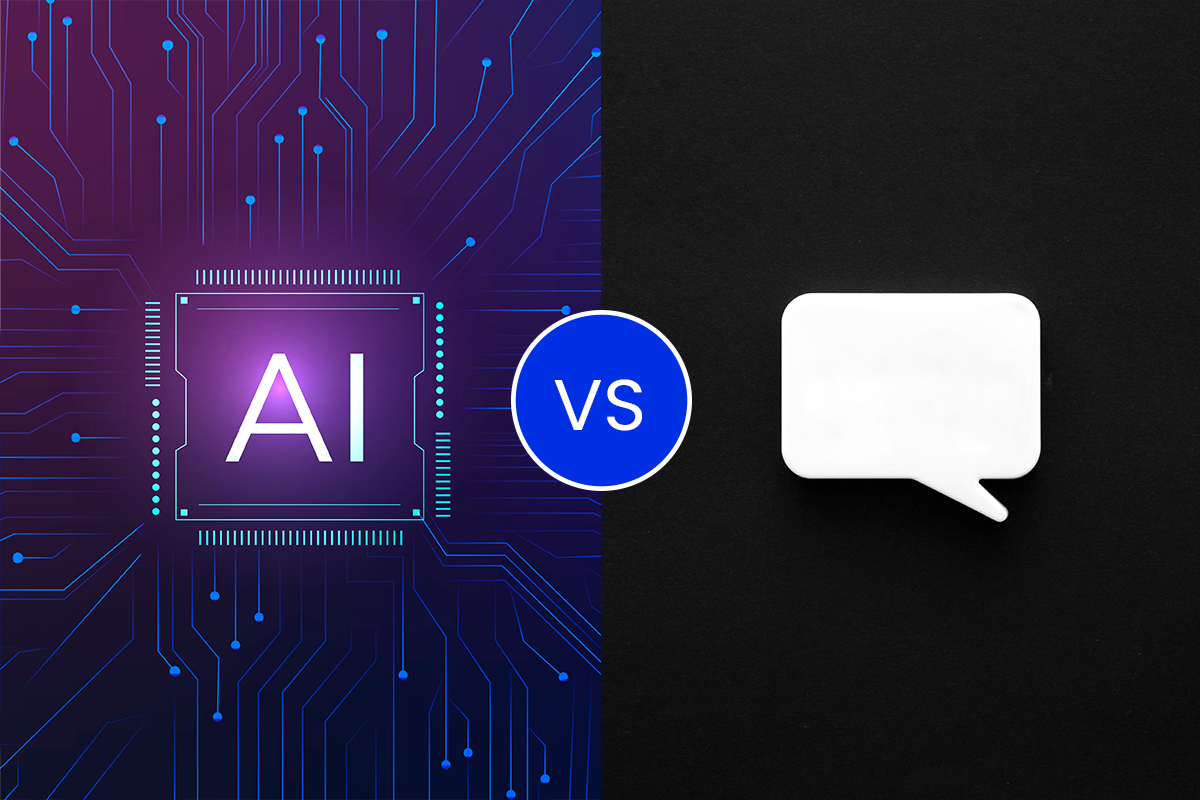Conversational AI and Chatbots are recurringly used interchangeably to expound the same thing, which to a small extent is valid but in the bigger picture, their distinctions are conspicuous and in a business context, consequential. Therefore, conversational AI and chatbots are far from being synonymous terms.

Chatbots and conversational AI have never been more popular than they are today. Hyro.ai states that the idea of AI and chatbots being the same thing stems from years of misleading semantics and misinterpretation that are endemic to any area or field that receives extreme recognition, attention and traction within a brief period of time. The capabilities of a chatbot are different from that of a conversational AI, but that does not mean that the two technologies aren’t related as conversational AI powers bots but not chatbots use conversational AI. Let’s start from square one, shall we?
What is a Chatbot?
Chatbots are known to follow tightly scripted and purely keyword-based conversations, also known to be predecessors of modern conversational AI. Theoretically speaking, Chatbots are essentially natural language text interfaces that are built with rules which encourage linear driven interactions and canned responses. These bots have distinct purposes and specific tasks that they manage to execute successfully. Bots have a reputation that it is easy to construct and are navigated by predefined steam or flows. Most of them exist as basic software programs that function in an application or operate through a website’s chat interface.
Source: whoson.com
Whoson.com notes that the most prevalent form of chatbot that you come often come across is the one that is accessed through a webchat window. Since chatbots are built only to provide responses to predetermined linear streams of conversations. While that is is the primary function of a chatbot it is also a large underlying problem that accompanies this model. This specific rigidity requires keying in of specific requests, leaving very little room for the bot’s comprehension of the conversation. Expanding on this thought leads to problem number two which is that chatbots cannot learn. Cognigy notes that chatbots are not useful for conversations or interactions that require them to intelligently comprehend what the customers are talking about.

Source: Medium
Therefore chatbots are established to be not ‘inteligent’ enough to use preceding conversations to corroborate contextual information. Due to this, any and all interactions with a chatbot will seem more or less the same simply because chatbots do not have the capability to learn, absorb or develop inbetween interactions and conversations. For instance, a chatbot is built to provide answers for problem X, problem Y and problem Z. To these, the bot will respond almost instantaneously but if a customer asks about anything other than these three then the bot may send or display an error sign or message.
That said, there are moments when chatbots come in handy for companies and businesses. Notably, chatbots best suited for companies that do not require anything more compound than a simple and affordable text equivalent of a user interface. Where the examination of conversational AI versus chatbots blurs is when the two types of available chatbots are considered.
- Rule-based chatbot
- AI-based chatbot
Most of the time, when ‘chatbots’ are being discussed they are most likely being referred to as flow or rule-based bots.
What about Conversational AI?
Conversational artificial intelligence or conversational AI is popularly known as the brand new user interface (UI). Theoretically speaking, it refers to the AI technology tools that are on the other side of conversational experiences with computer systems. That means that it refers to a host of AI technologies that enable computers to ‘smartly’ converse with customers. Let us break that down for you. Conversational AI basically enables and allows individuals to with speech-based assistants, messaging applications, smart devices and websites in regular day-to-day language through voice, video or text.
Conversational AI is known to execute judgement-intensive tasks and performs and handles multi-turn banter just like human beings. It concentrates on the dialogue flow system that manages human variance in human-computer interactions. The enterprise market, in particular, has resorted to conversational AI platforms in complex use cases like insurance, telecommunications, banking etc especially since chatbots failed to deliver on expectations. In addition to providing human-like experiences, unlike their rules-based counterparts; conversational AI is also capable of:
- Comprehending the meaning and intent of words
- Continuous improvement over time
- Carrying on a real or natural conversation
The platform of Conversational AI uses various technologies such as Natural Language Understanding (NLU), Natural Language Processing (NLP), Deep Learning, predictive analytics and Machine Learning to provide a human touch to individuals interacting with computers and machines. These technologies enable the AI bot to go beyond everyday human language as opposed to standard bots that can easily frustrate customers and ruin CX.

Source: whoson.com
Some of the key trends in the emerging technology of Conversational AI include:
- Voice recognition makes bots a unanimous choice as it enables smoother, hands-free and quicker interactions for users. Some notable examples include Alexa, Siri, and Google Assistant.
- Memory and recollection enable broader interactions especially when information-filled CRMs are integrated into chatbots. This makes carrying on previous conversations and looking up specific information regarding the customer, seamless and smooth.
- Personalization allows AI to tailor the interaction solely based on the customer behaviour, history and profile; responding to customers on a personal level and providing them with meaningful conversations.
- Machine learning operations play a significant role in improving and enhancing the ease and speed with which AI bots can be improved and trained. With advanced automation in place, it makes it convenient to update more frequently and easily.
Basic characteristic differences between Chatbots and Conversational AI
Chatbots and Conversational AI can be primarily differentiated based on some features.
When it comes to Chatbot:
- Focus on Keywords
Although chatbots don’t comprehend sentences, they can identify specific words customers type and provide an automated response based on that particular keyword identification.
- User Intentions
A customer intent or user intent refers to what a customer is trying to communicate with a bot. This involves the identification of a specific combination of keywords that the bot is familiar with. Chatbots are known to handle 100-200 customer intents.
- Swift deployment
Chatbots are fairly easy to deploy when compared to conversational bots which are more capable and powerful requiring a lengthier deployment duration.
When it comes to Conversational AI:
- User-friendly interfaces
The AI bot uses a modern, simple and graphical interface that makes it easier and faster to update the system. It also makes it easy and effortless for people without knowledge or a background in coding.
- Multiple language compatibility
While sharing the same integrations and overall cognition, these bots have the ability to work simultaneously in varied and multiple languages.
- Plug and play model
AI bots can meet daily expectations by providing instantaneous support as the extensions are of plug-and-play quality.
- Training and receptive systems
Customer support agents will be able to review NLU results and provide judgement and feedback based on semi-supervised and supervised learning solutions. Further, this will shape the AI bot to understand and respond to the company’s unique preferences with time.
What separates conversational AI from a regular chatbot?
- Ability to understand
Unlike chatbots, conversational AI has the ability to process and understand complex sentences of everyday language in the same humans do. It is a form of technology that can process, comprehend and navigate through human speech which preponderantly consists of abbreviations, slang, mispronunciations, misspelt words, fragments, etc. The bot has the capability to grasp these give-and-take exchanges.
- Ability to learn and develop
A conversational AI bot has the ability to use ample history and existing information available from voice and chat transcripts, existing interactions, training sessions, transactions etc. to learn and develop. This is something regular bots are incapable of doing making AI so much more superior as it can respond, engage, recommend, humanly interact, etc. based on these learnings.
- Ability to know and identify
AI bots unlike their lesser advanced counterparts can be seamlessly integrated into enterprise systems and can get acquainted with the company. Through integration, it will recognize, identify and work on improving processes, making current interactions more efficient and seamless, and troubleshoots or resolves issues in customer support.
- Ability to text, chat and talk
Conversational AI is seamless and ubiquitous across all platforms, applications, or channels. Unlike regular bots, these have the capability to handle omnichannel integrations and interactions.
Conversational AI v/s Chatbots
Source: hyro.ai
On the basis of Core Organizational Functions, some of the dissimilarities are as follows:
#1 Conversational AI provides better customer experiences or CX when compared to Chatbot
Basic chatbots are handicapped when it comes to providing appropriate and quick responses to customers in order to assist them better with reduced complications and improved CX quality.
#2 Chatbots provides ease of implementation when compared to Conversational AI
Chatbots are essentially more straightforward and simple to implement as opposed to conversational AI to the point where an individual with no coding expertise can install and customize the system. Chatbots provide basic responses to trained queries making them usable for basic interactive customer service.
#3 Conversational AI offers better customer support when compared to Chatbots
In comparison to chatbots, AI-powered bots do a better job at providing customer support. Comparatively, that would imply a more consistent flow of data and information, higher hourly resolved cases, and lesser stressed employees as they do not have to spend too much on repetitive routine tasks.
#4 Conversational AI provides lower wait times when compared to Chatbots
AI bots can handle more customer service volume when compared to chatbots which means they can functionally automate standard processes and high volume interactions. This will eventually lead to lesser hold time and faster and better resolutions.

